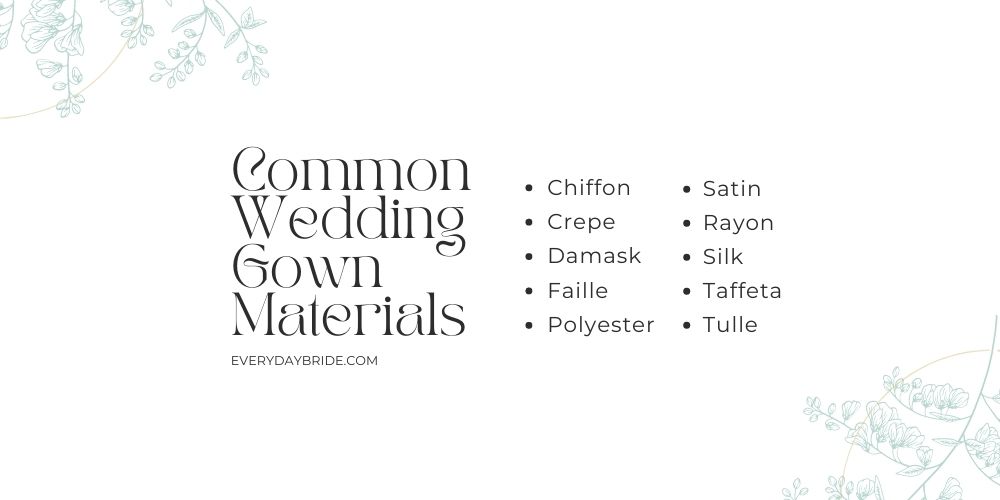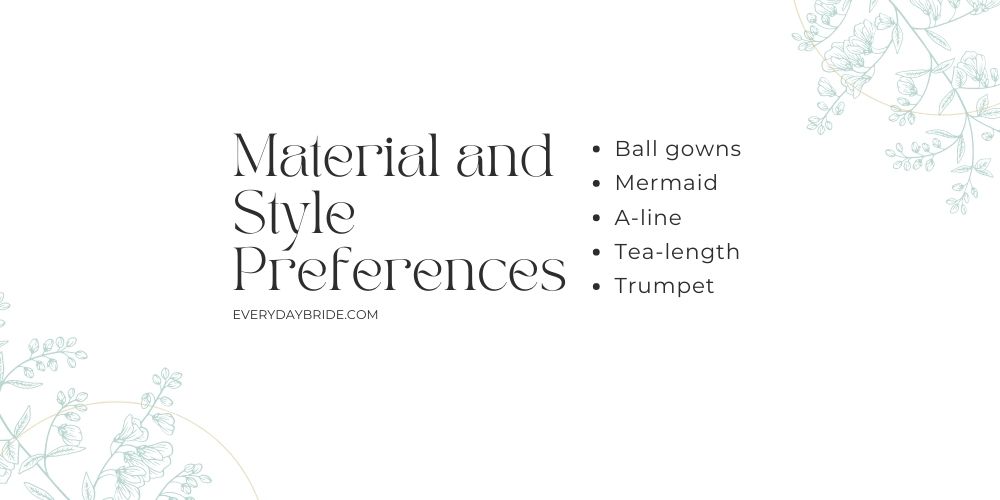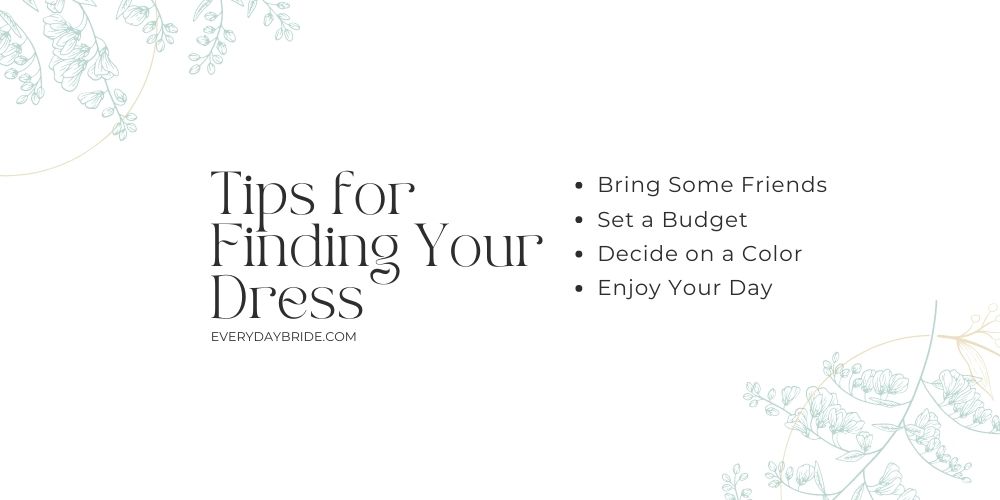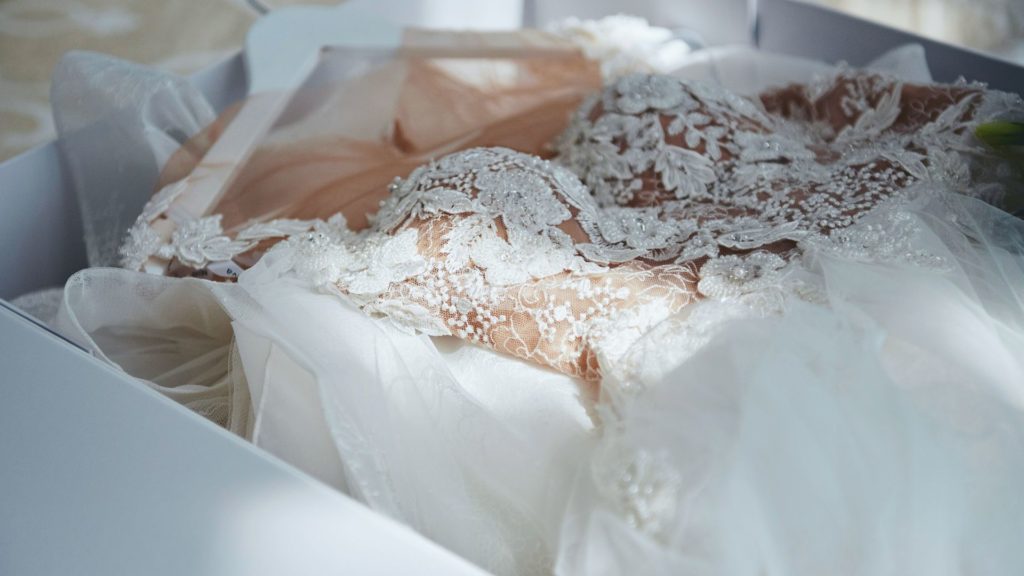Shopping for your bridal dress is one of the most thrilling parts of planning a wedding. Trying gowns on is fun and makes your dream wedding feel more real. All the pieces are finally coming together. In this extensive guide to choosing the best wedding gown fabric, we’ll discuss the following topics:
- Common wedding gown materials
- Dress styles and fabrics
- Tips for dress shopping
Often, fabric type impacts the type of dress you buy since some materials are more flowing while others are stiff. Learn all about these tips to make shopping a breeze!

Common Wedding Gown Materials
As you begin wedding dress shopping, you may be surprised by all the different materials used for gowns. Some dress skirts appear poofy, while others are sleek and shiny. While cut and style are two major factors impacting the look of a wedding gown, the fabric is also vital.
Some of the many fabrics commonly used for wedding dresses include:
- Chiffon
- Crepe
- Damask
- Faille
- Polyester
- Satin
- Rayon
- Silk
- Taffeta
- Tulle
Why does gown material matter? Because options such as chiffon and tulle have vastly different appearances. These also are ideal for different types and come at varying price points. Like achieving the dream wedding, finding your perfect dress means understanding exactly what you’ll pay for.
Chiffon
Chiffon fabric originated in France and is a sheer fabric. If the material is “sheer,” it’s slightly transparent and usually used on an opaque fabric—the dress has layers.
This is an ideal material for weddings during warmer times of the year, thanks to the fabric’s flowy aesthetic. So if you’re having a beach wedding in June, a chiffon dress will be lightweight and flowy enough to prevent overheating.
Bridal Tip
One major con of this material is that it snags easily, so you’ll want to choose the jewelry you wear to match the dress and avoid this mishap.
Crepe
If you want a dress that hugs your beautiful curves in all the right places but still has some flare in the skirt, crepe is a great material. This popular wedding gown fabric clings to the body in a fitted design, but when the material is looser— such as in the skirt—it will drape around you. Most fashion experts agree that crepe creates the timeless look some brides desire.
Damask
Similar to chiffon, damask is a lightweight fabric. Unlike chiffon, dress designers use damask for dresses regardless of the time of year. Damask is also more formfitting, so it’s perfect for a bride who wants a dress that’ll show off her figure. Historically, manufacturers used silk for damask fabric, but today, they can also use cotton, wool, or synthetic materials, such as polyester.
Faille
When dressmakers use faille, crafting a structured dress that holds its shape is easier. While the material is typically a silk blend, various materials, such as cotton and rayon, are now used to weave it. Since the fabric is a bit heavier, it’s more popular for fall and winter weddings, though you’ll see it worn throughout the year.
Faille dresses make the “less is more” motto a reality. These dresses look elegant yet simple—there isn’t applique or other complex designs sewn onto them, as you may see with chiffon.
Polyester
Looking for a cost-effective material? Polyester is a synthetic fabric sometimes blended with other materials to create the appearance of satin, chiffon, and other high-end dress fabrics. Maintaining polyester dresses is also far easier than a natural material since it’s more durable and less likely to wrinkle.
Keep in mind that a polyester bridal gown is less breathable than one made with natural materials. So wearing it for a spring or summer wedding may not be ideal if you have an outdoor venue. After hours of getting your makeup professionally done, the last thing you want is to sweat because you’re too hot— and not hot in the way you’d hoped!
Rayon
Rayon is another inexpensive option that combines natural and synthetic materials. This is also a great choice because of its elasticity. Wearing a fabric with some stretch feels more comfortable to some individuals, especially after enjoying all that delicious wedding food.
Bridal Tip
This material is also a great choice for any brides-to-be with a little one on the way. The elastic nature of the rayon will hug your body without feeling constricting.
Satin
Satin is good if you want a beautiful dress with a bit of shine that’ll wow everyone during your debut down the aisle and when they see your wedding photos. This material gets its smooth, soft look from the silk fibers often used to make it. As the name implies, satin is always shiny, so you won’t find a matte gown made of satin. Moreover, satin comes in varying thicknesses, so brides can comfortably wear it any time of year.
Silk
While silk may be ideal for your traditional, extravagant wedding gown, it also comes with a high price tag. Brides have worn silk dresses for centuries because they’re always in style, work for every season, and create a look of beauty and grace. Common types of silk include dupioni, gazar, and faille.
Taffeta
Taffeta is an interesting material since we determine quality by stiffness—the stiffer, the better. Some dress designers use taffeta as an underlayer on wedding gowns and then lay tulle, chiffon, or lace over it with embroidery sewn into them. Taffeta holds its shape easily, so if the dress has several layers of material, you don’t need to add a petticoat to give it shape.
Tulle
Many of us have owned dresses with tulle as an underlayer to add to the poof of the skirt. However, when it comes to wedding gowns, tulle may also be a top layer of the dress. This material is airy, allowing it to flow easily with a slight breeze. Designers often make veils out of tulle because of its flowy nature. Some designers stitch applique onto the tulle, such as flowers or cleaves, to make the gown even more extravagant.

Material and Style Preferences
Now that we’ve discussed options for choosing the best wedding gown fabric, let’s get into dress style options. After all, this extensive guide would be incomplete without covering such a vital detail.
The main wedding dress styles include:
- Ball gowns
- Mermaid
- A-line
- Tea-length
- Trumpet
Each style best suits various frames, so you should know what styles flatter your body type before you start shopping. Of course, if you have no idea what your body type is, an employee at the bridal boutique can assist with this.
Ball Gowns
Ball gowns are a wonderful option for a bride hoping to look like royalty on her wedding day. This dress is typically fitted in the body but flares at the skirt. The skirt starts above the natural waist, creating a smaller look for the upper half of the body.
Typically, ball gowns are best for rectangle and pear body shapes because they’re snug around the waist and pull attention away from your hips.
Common Fabrics Used for Ball Gowns
Since these dresses need to hold their shape, common materials include satin, chiffon, tulle, and taffeta. Each of these materials either does a superior job maintaining its shape or helps the dress keep its full figure.
A-Line
An A-line dress remains fitted in the bodice but flares at the skirt. Unlike a ball gown, an A-line dress doesn’t have the full, princess-like, skirt. Moreover, the skirt starts at your natural waist in an A-line dress.
A-line dresses are often ideal because they look incredible on all body types! So if you have just started dress shopping and know what style to start with, this is great. You’ll feel beautiful and can work with the salesperson to determine other styles you should try next if A-line isn’t perfect.
Common Fabrics Used for A-Line Dresses
Most designers make A-line dresses with crepe, taffeta, or polyester.
Mermaid
Mermaid dresses are a top pick for brides searching for a dress that creates an alluring look and shows off their fabulous curves. Wedding gowns of this style remain snug around the body until the mid-thigh, where the skirt pools out.
This dress style is ideal for hourglass figures because your curves are through the shoulders and hips, which is where this dress is most snug.
Common Material Used for Mermaid Dresses
Often, designers use crepe when crafting a mermaid dress. This is because of how the fabric naturally clings to the body—a key feature.
Trumpet
Trumpet dresses are similar to mermaids but not identical. Although trumpet dresses are fitted around much of the body like a mermaid, they’re more draped than the former. Plus, trumpet dresses flare out, while mermaid-style dresses have a fuller look. Similar to mermaids, trumpet dresses best suit hourglass body types.
Common Materials Used for Trumpet Dresses
Materials such as silk or crepe are great for trumpet dresses due to the natural way these fabrics fit the body.
Tea-Length
When most of us imagine a wedding dress, we think of a full-length gown, but that’s not the only option. Tea-length wedding dresses end at the ankles—midi-skirt—or mid-thigh like a miniskirt, depending on your preference. This is an excellent option if you want a dress that combines vintage with modernism, as this dress style first became popular in the ’20s. Tea-length dresses became wedding dress options in the 1950s.
Typically, tea-length gowns are most suited for pear-shaped bodies because they flare at the hips while also drawing attention to the small upper body.
Common Materials Used for Tea-Length Dresses
Silk, satin, or chiffon are the most common materials designers use when making tea-length dresses.

Tips for Finding Your Dress
Finding the ideal wedding dress can become a bit of a hunt. Some brides-to-be visit countless bridal shops before finally finding the dress. Other women say “yes” right away. While this can be a matter of how decisive you are, other factors, such as your support and how much money you’ll spend, hold significant weight in this decision.
Bring Some Friends
Your bridesmaids are the most loyal of supporters and are ready to help you with all the wedding prep. Deciding who to bring for wedding dress shopping can feel tricky because you don’t want anyone to feel excluded. Typically, women invite bridesmaids, their mothers, and future mothers-in-law.
Consider which individuals offer the best advice as you decide who to bring. If someone can be a bit too critical, they may not be the best guest. Your entourage should include individuals who:
- Understand your fashion taste
- Know what looks best on you
- Can get you exploring other options
Most importantly, you need honest people. While no one needs to say, “That dress looks horrible on you,” they should say, “Maybe another option would flatter your body better.” The truth is important but shouldn’t be insulting.
Set a Budget
Wedding dresses can skyrocket in price quickly, and you have a fixed number to work with. Decide how much of the wedding budget you’ll spend on fashion. This should account for the dress plus alterations. As you consider your wedding attire, remember to save money for hair, makeup, veil, shoes, and other accessories—all are key parts of wedding fashion.
When you go wedding dress shopping, start with gowns below your budget. For instance, if you plan to spend $1700, start with dresses closer to $1300. If you tell the salesperson $1700 is your limit, they’ll pull most dresses at that price; the fee is before taxes and alterations.
Decide on a Color
While white, blush, and ivory are the most traditional for wedding gowns, they’re not your only options. Some brides decide on nontraditional wedding gown colors such as bright and passionate red. Many fabrics come in varying colors because this simply requires dying the material. If you have a specific color in mind, go into the shop already knowing this.
Enjoy Your Day
Understanding the many dress fabrics helps you decide what your perfect wedding dress looks like. For example, if you want a dress with some shine, search for satin gowns. On the other hand, if you want an alluring mermaid dress to show off your figure, the gown should be crepe.
Enjoy every moment of bridal dress shopping. Try on dresses you may not normally consider, make memories with friends, and let the champagne flow once you finally say “yes” to your dream dress.


